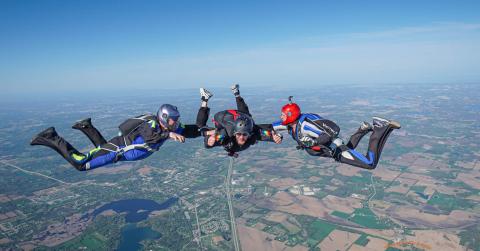How Can I Learn To Skydive Solo?

How Do I Learn To Be a Solo Skydiver?
Ever wonder how skydivers learn to jump by themselves and how they progress to that point? A solo skydiver, also known as a sport jumper or “fun” jumper, starts off either as a tandem or they sign up for a skydiving course. There are a few different ways to start jumping your own rig and parachute, each with its own “ups and downs.” Here are the most common methods to learn how to be a sport jumper:
1. Tandem Skydiving: Tandem skydiving is a popular portal for beginners who want to feel the rush of skydiving without extensive training. On a tandem jump, the student is securely harnessed to an experienced instructor who controls the skydive—with proper training, the student *may* participate in aspects of the skydive if they make that request. Tandem jumps are a great way to ease yourself into the sport.
2. Static Line Progression (SL): Static Line progression involves jumping solo from an aircraft with a static line attached to the aircraft. The line automatically deploys the student's parachute shortly after exiting the aircraft. This method focuses on teaching the student proper canopy control and landing techniques from the early stages. SL progression gets students jumping and controlling their parachute with less freefall time.
3. Accelerated Freefall (AFF): If you want to learn solo skydiving near you, the Accelerated Freefall program is how students are trained at Skydive Milwaukee. In AFF, students progress to solo freefall jumps relatively quickly. After comprehensive ground training students exit an aircraft accompanied by two instructors who provide hands-on assistance and supervision during the initial jumps. As the student progresses through the levels, the amount of instructor assistance decreases until they can perform jumps on their own. AFF emphasizes freefall skills and canopy control simultaneously.
4. Static Line Assisted Deployment (S/LAD): S/LAD is similar to the static line progression method, but with a slight variation. Instead of a fixed static line, the student deploys their own parachute by manually throwing a pilot chute, which initiates parachute deployment. S/LAD combines the controlled deployment of a static line with the student's involvement in manually deploying the parachute.
5. Coach-Assisted Freefall (CAFF): Coach-Assisted Freefall is a method that bridges the gap between tandem skydiving and Accelerated Freefall. In this method, the student jumps with a coach who provides hands-on assistance and guidance during freefall. The coach helps the student maintain stability and practice essential skills while gradually transitioning to solo jumps.
The choice is dependent on personal preference, time commitment, budget, and desired level of involvement in the learning process. Give us a call, come see us in action, get to know students who are in the AFF program. We hope to be your choice for reaching your ultimate goal!




